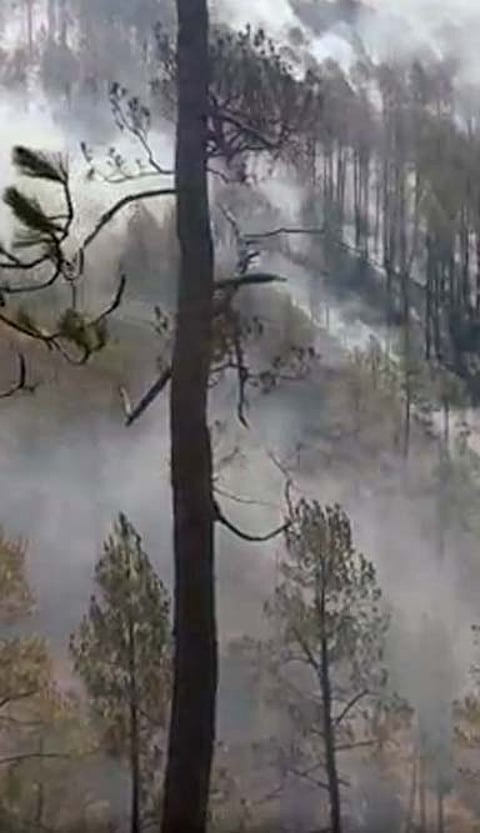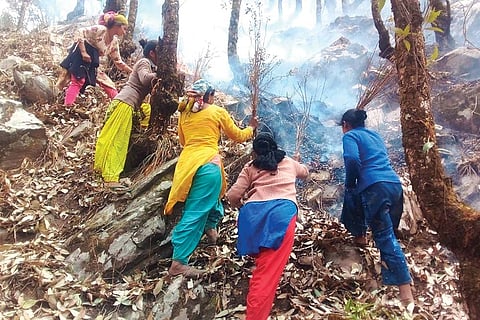Fire Alerts
Wildfires Keep Pockets Warm
Pious official rhetoric burns incandescently. World Environment Days come and go. Meanwhile, our hillside verdure routinely turns to cinder. Why?
- 3,86,804 January 1-June 5, 2021
- 1,43,489 in 2020
- 2,10,074 in 2019
*National figures by Forest Survey of India
***
The annual day for those familiar platitudes from politicians, bureaucrats, celebrities and social media influencers about the urgent need for protecting our environment just went by. There was rhetoric aplenty on June 5 as India marked the World Environment Day. Some planted a tree and posted a selfie. Now picture this on a serious note. PM Narendra Modi declared that India is emerging as a leader in “climate justice” by setting an example “in front of the world that development work needn’t be blocked while trying to protect the environment”. Union minister for environment and forests Prakash Javadekar followed with this: “India is one of the few countries where forest cover has actually increased in the past decade, reaching 24.56 per cent of the geographic area of the country.”
Hours before we patted our backs over India’s triumphs in ecosystem restoration, the theme of this year’s World Environment Day, the Forest Survey of India (FSI) had, between 1.40 am and 1.46 am, sent out six fire alerts. These were from the Chambal sanctuary range and Sultanpura range in Rajasthan, Jharsuguda and Talcher ranges in Odisha, and Mandu and Burmu ranges in Jharkhand. Between January 1 and June 5, there were 3,86,804 forest fire alarms from the SNPP-VIIRS (Soumi National Polar-orbiting Partnership–Visible Infrared Imaging Radiometer Suite) satellite sensors. This was more than the total alerts issued for the same period in the past two years—1,43,489 in 2020 and 2,10,074 in 2019, respectively. This means the past five months recorded the highest number of forest fires since the FSI’s alert system was upgraded in 2019 for more nuanced warnings. The staggering numbers remained under the public radar.
Fire hotspots detected by the sensors are based on near real-time fire point data. FSI alerts this year indicate that the highest incidence of forest fires was reported from Odisha (56,831). Telangana (20,502), Maharashtra (37,158), Madhya Pradesh (54,303), Chhattisgarh (40,913) and Uttarakhand (21,274) too have witnessed frequent wildfires. A majority of these fires were controlled within a short time. However, their frequency and the inability of forest departments to prevent recurrence have led to questions on the possible causes of these conflagrations.

A firefighting helicopter collects water from the Tehri dam in Uttarakhand
A 2019 report of the FSI, which analysed forest fire points detected in the 13 preceding years to identify fire-prone areas, stated that “95 per cent fire incidences are of anthropogenic origin”. The 2019 India State of Forest report estimated that 36 per cent of India’s forest cover is prone to frequent forest fires. “Uncontrolled fires of anthropogenic origin are a serious concern for sustainability of forests…. Traditional fire fighting methods and equipments may not be sufficient to fight the growing number of large forest fires,” the report warned.
Nearly two years later, India’s forest authorities appear clueless on how they plan to tackle man-made forest fires. “People living in forest areas know exactly who is responsible for the fires,” says Aagnay Budhraja, a resident of Surya Gaon, a village near Sattal in Uttarakhand. “Though some fires started by farmers to burn stubble spiral out of control, incidents of planned fires by the timber mafia are a recurring problem. In the forests around Nainital, Sattal, Almora and Binsar, any villager will tell you who are involved in deliberately setting the forest on fire, but the officials do precious little to identify them.”

A woman sorts ripe mahua in Jharkhand
In the first week of April, Uttarakhand reported 361 incidents of fire that decimated 567 hectares of the state’s forest cover, bringing back horrifying memories of the summer of 2016 when nearly 4,500 hectares of the state’s forests were turned into ash in 2,074 incidents. Things aren’t very different in the neighbouring hill state of Himachal Pradesh. Although successive government reports have claimed that 94 per cent of Himachal’s forests fall in the “less fire-prone” category, ground realities and FSI alerts issued in the past five months paint a picture in contrast. The state loses 6,000 to 15,000 hectares of forest cover each year to wildfires. India’s usual forest fire season falls between the months of February and June—predominantly summer months when drying leaves and undergrowth provide a high fuel load for bushfires. In states like Himachal and Uttarakhand, a heavy density of oil-rich pine trees that shed highly combustible needles provides ready fuel load. Unchecked small forest fires here evolve quickly into an inferno.
By May, Himachal reported 633 major wildfires this year. V.P. Mohan, a former principal chief conservator of forests in the state, concedes that “the majority of forest fires in Himachal are deliberately lit by the locals”, but only because of a prevailing belief that controlled surface fires lead to better growth of grass once the fire is extinguished. “These fires sometimes spread and become uncontrollable,” Mohan adds. Ecology activist Mansi Asher doesn’t agree entirely with Mohan and argues that the “timber mafia is the biggest gainer” from uncontrolled wildfires in Himachal.

The Burning Pines in the hills of Himachal
Raging forest fires provide a perfect way to erase evidence of human involvement. “Forest fires are a ready means to destroy evidence and so it is extremely difficult to ever get convictions even if arrests are made,” says a retired IAS officer, who worked as secretary in Madhya Pradesh’s forest department. The involvement of “country liquor mafia” along with the timber and land mafia is an oft-quoted cause for forest fires in MP, Chhattisgarh, Uttar Pradesh and Jharkhand—all states that have forests with a rich density of mahua trees. “If proper investigation is ever carried out, the involvement of timber and country liquor mafia in the forest fires in these states will certainly be unearthed. But these criminals work under full protection of the government and administrative machinery,” says the retired IAS officer.
On March 28, massive fires broke out simultaneously across seven ranges of MP’s famous Bandhavgarh Tiger Reserve (BTR). Though the state government claims that “only one per cent of the BTR’s total area of 1,536 square kilometres was affected by the fire and there was no loss to wildlife”, there are few takers for this claim. The fire at BTR, home to nearly 80 tigers, raged on for over four days and chief minister Shivraj Singh Chouhan had to break protocol by directing the civil administration, as opposed to the forest department, to press in measures for extinguishing the blaze.
Various theories on who started the fire in BTR have since been proffered. Not one involves natural causes. “The fire happened during the season when locals collect mahua flowers to use in cooking and to make local brews,” says the state’s forests minister Vijay Shah. “Sometimes locals light small fires because it’s easier to identify the white flowers that fall on an ashen ground. Another probable cause of the fire could be villagers around BTR trying to chase away a herd of elephants that entered Bandhavgarh from Chhattisgarh last year and continues to cause damage to life and property.”

The Traditional Way—Women try to extinguish flames at a firebreak by thrashing at it with sticks
Weeks before the BTR fire, the Simlipal biosphere reserve in Odisha’s Mayurbhanj witnessed sudden eruption of fires across various parts of the forest through much of February. By March 5, the fire had engulfed large parts of Simlipal and had raged on for 11 days. It was only around March 10 that a spell of rainfall snuffed out the blaze. Two months on, the investigation into the wildfire hasn’t concluded as yet.
The sudden spike in unexplained forest fires and alerts this year also has another worrying dimension to it. “It may just be coincidence, but states that have seen a huge spike in forest fires this year are also those that witnessed waves of reverse migration from big cities due to the Covid-induced lockdowns and subsequent economic hardships,” says conservationist Vikrant Tongad, founder of SAFE (Social Action for Forest and Environment). “While it may be too early to say anything conclusively, it is worth probing whether several of these reverse migrants, who returned to their home states such as Himachal Pradesh, Uttarakhand, Madhya Pradesh, parts of Maharashtra and Odisha, have been forced to join locally operating mafia cartels or are indulging in other activities that cause harm to the forests.”
Mafia, poachers, accidental fires or natural phenomenon, the fact remains that India has a problem of uncontrolled forest fires unleashing destruction at an exponential rate. The devastating second wave of the Covid pandemic has just made a nation gasping for breath aware of the need to stock up on industrial oxygen. What sort of pandemic will it take for us to conserve India’s vast swathes of natural oxygen concentrators that are being consigned to flames to feed the greed of a few, while a clueless administrative and enforcement apparatus offers banal bromides on ecosystem restoration annually on World Environment Day?
***
Major Forest Fires In 2021
Odisha: Simlipal Biosphere Reserve in Mayurbhanj (between February and April)
Madhya Pradesh: Bandhavgarh Tiger Reserve in Umaria (in March)
Mizoram: Forest fires in the Lunglei and Lawngtlai districts (in April)
Uttarakhand: over 40 forest fires broke out across Garhwal and Kumaon regions in April; Almora, Nainital, Tehri and Pauri were the worst-hit.
Himachal Pradesh: Between February and May 633 major wildfires were reported; worst-hit districts were Mandi and Bilaspur
Chhattisgarh: Between February 15 and March 22, the state recorded 6,520 forest fires; mostly in Bijapur district and Udanti Sitanadi forest reserve in Gariyaband district
Jharkhand: Forest fires in Jonha, Sitafall and Angara forests surrounding Ranchi in March
Nagaland and Manipur: A wildfire at Dzukou Valley straddling the Manipur-Nagaland border raged for two weeks in January